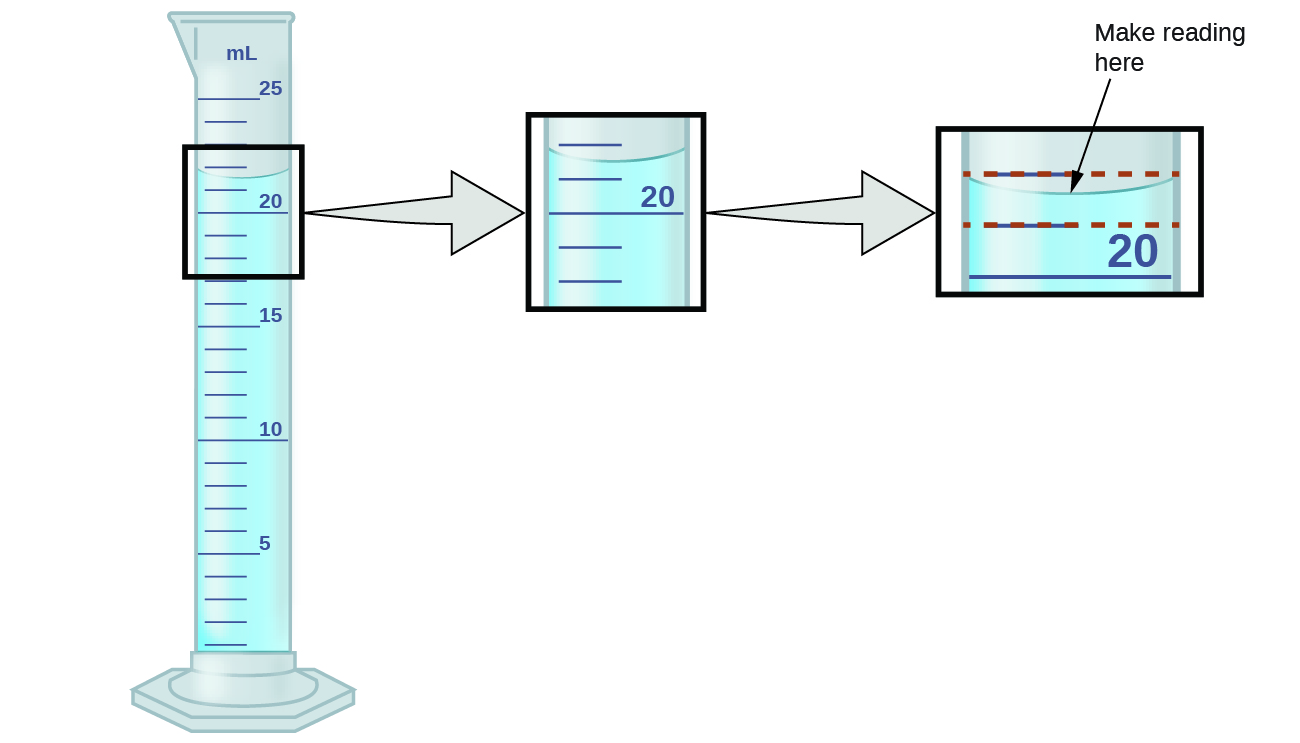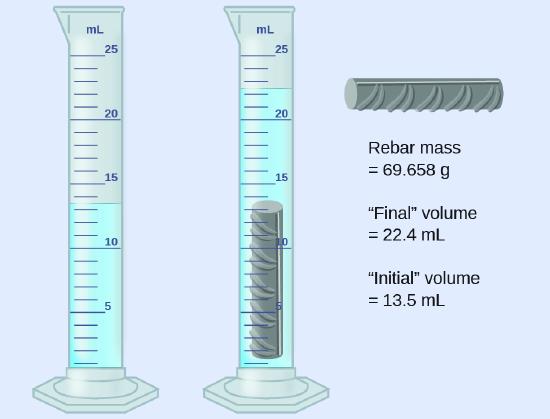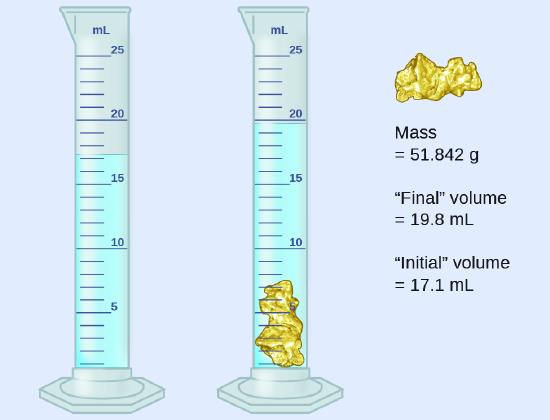what is the density of the liquid to the correct number of significant figures
2.four: Meaning Figures
- Page ID
- 98528
Skills to Develop
- Define accuracy and precision
- Distinguish exact and uncertain numbers
- Correctly represent uncertainty in quantities using meaning figures
- Employ proper rounding rules to computed quantities
We have seen how of import measurements are to the scientific procedure. Scientists demand to make measurements equally authentic as possible in order to draw conclusions from their experiments. In society to avoid errors, however, scientists also need to be articulate virtually how precise their measurements are, or are not, when reporting their data. No measurement tool is perfect, and so every measurement we brand with imperfect tools has some amount of dubiousness associated with it.
Counting is the only type of measurement that is free from uncertainty, provided the number of objects being counted does non alter while the counting process is underway. The issue of such a counting measurement is an instance of an exact number . If we count eggs in a carton, we know exactly how many eggs the carton contains. The numbers of defined quantities are also exact. By definition, 1 foot is exactly 12 inches, one inch is exactly 2.54 centimeters, and i gram is exactly 0.001 kilogram. Quantities derived from measurements other than counting, however, are uncertain to varying extents due to practical limitations of the measurement process used. Chemists utilise the concept of significant figures to indicate the level of incertitude in measured quantities or values calculated based on measured values.
Significant Figures in Measurement
The numbers of measured quantities, dissimilar defined or directly counted quantities, are not verbal. To measure out the book of liquid in a graduated cylinder, y'all should make a reading at the bottom of the meniscus, the everyman point on the curved surface of the liquid.

Figure \(\PageIndex{one}\): To measure the volume of liquid in this graduated cylinder, you must mentally subdivide the distance between the 21 and 22 mL marks into tenths of a milliliter, and then brand a reading (approximate) at the bottom of the meniscus.
Refer to the analogy in Figure \(\PageIndex{ane}\). The lesser of the meniscus in this case conspicuously lies between the 21 and 22 markings, meaning the liquid volume is certainly greater than 21 mL but less than 22 mL. The meniscus appears to be a bit closer to the 22-mL marking than to the 21-mL mark, and so a reasonable judge of the liquid'due south volume would be 21.6 mL. In the number 21.6, then, the digits 2 and ane are certain, but the 6 is an estimate. Some people might gauge the meniscus position to be equally distant from each of the markings and estimate the tenth-place digit as 5, while others may think it to be even closer to the 22-mL mark and judge this digit to be 7. Notation that it would be pointless to try to guess a digit for the hundredths place, given that the tenths-identify digit is uncertain. In general, numerical scales such as the one on this graduated cylinder volition let measurements to ane-tenth of the smallest calibration sectionalization. The calibration in this example has 1-mL divisions, so volumes may be measured to the nearest 0.1 mL.
This concept holds true for all measurements, even if you do not actively make an gauge. If you identify a quarter on a standard electronic rest, you may obtain a reading of 6.72 k. The digits 6 and 7 are certain, and the two indicates that the mass of the quarter is likely between 6.71 and 6.73 grams. The quarter weighs well-nigh half dozen.72 grams, with a nominal uncertainty in the measurement of ± 0.01 gram. If we counterbalance the quarter on a more than sensitive balance, nosotros may find that its mass is 6.723 g. This means its mass lies betwixt vi.722 and 6.724 grams, an dubiousness of 0.001 gram. Every measurement has some dubiety, which depends on the device used (and the user's ability). All of the digits in a measurement, including the uncertain last digit, are called significant figures or significant digits. Note that zero may exist a measured value; for case, if you stand up on a scale that shows weight to the nearest pound and it shows "120," then the ane (hundreds), 2 (tens) and 0 (ones) are all significant (measured) values.
Whenever y'all make a measurement properly, all the digits in the result are meaning. But what if you were analyzing a reported value and trying to determine what is significant and what is not? Well, for starters, all nonzero digits are pregnant, and it is but zeros that require some thought. We will use the terms "leading," "trailing," and "captive" for the zeros and will consider how to deal with them.
Starting with the first nonzero digit on the left, count this digit and all remaining digits to the right. This is the number of pregnant figures in the measurement unless the last digit is a trailing zero lying to the left of the decimal betoken.

Captive zeros effect from measurement and are therefore always pregnant. Leading zeros, however, are never significant—they merely tell us where the decimal indicate is located.

The leading zeros in this case are not significant. Nosotros could use exponential notation (as described in Appendix B) and express the number as 8.32407 \(\times\) 10−3; then the number 8.32407 contains all of the pregnant figures, and 10−iii locates the decimal point.
The number of significant figures is uncertain in a number that ends with a zero to the left of the decimal point location. The zeros in the measurement 1,300 grams could be significant or they could simply indicate where the decimal point is located. The ambiguity can exist resolved with the use of scientific notation: 1.3 \(\times\) 103 (two significant figures), 1.30 \(\times\) tenthree (three significant figures, if the tens place was measured), or ane.300 \(\times\) 10iii (four meaning figures, if the ones place was likewise measured). In cases where only the decimal-formatted number is available, information technology is prudent to assume that all trailing zeros are not significant.

When determining significant figures, be sure to pay attention to reported values and remember about the measurement and meaning figures in terms of what is reasonable or likely—that is, whether the value makes sense. For instance, the official January 2014 census reported the resident population of the United states as 317,297,725. Do yous think the US population was correctly determined to the reported nine meaning figures, that is, to the exact number of people? People are constantly being born, dying, or moving into or out of the land, and assumptions are fabricated to account for the large number of people who are not really counted. Considering of these uncertainties, it might exist more reasonable to expect that we know the population to within perhaps a million or so, in which instance the population should be reported as 317 million, or \(3.17 \times 10^viii \) people.
Pregnant Figures in Calculations
A second of import principle of doubt is that results calculated from a measurement are at least every bit uncertain as the measurement itself. We must have the uncertainty in our measurements into account to avoid misrepresenting the uncertainty in calculated results. One way to practice this is to report the issue of a calculation with the correct number of significant figures, which is adamant by the following iii rules for rounding numbers:
- When we add together or subtract numbers, we should circular the outcome to the same number of decimal places as the number with the least number of decimal places (the least precise value in terms of add-on and subtraction).
- When nosotros multiply or divide numbers, we should circular the result to the same number of digits as the number with the least number of significant figures (the to the lowest degree precise value in terms of multiplication and partitioning).
- If the digit to exist dropped (the one immediately to the right of the digit to be retained) is less than 5, we "circular down" and go out the retained digit unchanged; if it is more than 5, we "round upwards" and increase the retained digit by 1; if the dropped digit is v, we circular up or down, whichever yields an even value for the retained digit. (The last part of this rule may strike y'all as a scrap odd, but it's based on reliable statistics and is aimed at avoiding whatever bias when dropping the digit "5," since it is equally shut to both possible values of the retained digit.)
The post-obit examples illustrate the awarding of this dominion in rounding a few dissimilar numbers to three meaning figures:
- 0.028675 rounds "upward" to 0.0287 (the dropped digit, 7, is greater than five)
- 18.3384 rounds "downwards" to eighteen.iii (the dropped digit, 3, is less than five)
- 6.8752 rounds "upwardly" to six.88 (the dropped digit is 5, and the retained digit is even)
- 92.85 rounds "down" to 92.8 (the dropped digit is 5, and the retained digit is even)
Let'southward piece of work through these rules with a few examples.
Example \(\PageIndex{1}\): Rounding Numbers
Circular the following to the indicated number of meaning figures:
- 31.57 (to 2 significant figures)
- 8.1649 (to three significant figures)
- 0.051065 (to four pregnant figures)
- 0.90275 (to four significant figures)
Solution
- 31.57 rounds "up" to 32 (the dropped digit is v, and the retained digit is fifty-fifty)
- eight.1649 rounds "down" to viii.xvi (the dropped digit, four, is less than 5)
- 0.051065 rounds "down" to 0.05106 (the dropped digit is 5, and the retained digit is even)
- 0.90275 rounds "up" to 0.9028 (the dropped digit is 5, and the retained digit is even)
Exercise \(\PageIndex{1}\)
Round the post-obit to the indicated number of significant figures:
- 0.424 (to 2 significant figures)
- 0.0038661 (to three significant figures)
- 421.25 (to 4 significant figures)
- 28,683.5 (to 5 significant figures)
- Answer a
-
0.42
- Answer b
-
0.00387
- Respond c
-
421.ii
- Respond d
-
28,684
Example \(\PageIndex{2}\): Addition and Subtraction with Meaning Figures Rule:
When we add or subtract numbers, nosotros should round the event to the same number of decimal places equally the number with the least number of decimal places (i.due east., the least precise value in terms of addition and subtraction).
- Add one.0023 one thousand and iv.383 1000.
- Decrease 421.23 g from 486 1000.
Solution
(a)
\[\brainstorm{align*}
&\mathrm{1.0023\: g}\\ +\: &\underline{\mathrm{iv.383\: k}\:\:}\\ &\mathrm{5.3853\: g}
\end{align*}\]
Reply is 5.385 g (round to the thousandths place; three decimal places)
(b)
\[\begin{align*}
&\mathrm{486\: yard}\\ -\: &\underline{\mathrm{421.23\: thou}}\\ &\mathrm{\:\:64.77\: 1000}
\stop{align*}\]
Answer is 65 g (round to the ones identify; no decimal places)

Exercise \(\PageIndex{2}\)
- Add 2.334 mL and 0.31 mL.
- Decrease 55.8752 1000 from 56.533 m.
- Answer a
-
2.64 mL
- Answer b
-
0.658 m
Case \(\PageIndex{3}\): Multiplication and Segmentation with Significant Figures
Rule: When we multiply or divide numbers, we should round the result to the same number of digits as the number with the least number of meaning figures (the least precise value in terms of multiplication and segmentation).
- Multiply 0.6238 cm past 6.six cm.
- Carve up 421.23 g past 486 mL.
Solution
(a)
\[\mathrm{0.6238\: cm\times6.6\:cm=iv.11708\:cm^ii\rightarrow issue\: is\:4.1\:cm^2}\:\textrm{(round to ii significant figures)}\]
\[\textrm{4 significant figures}\times \textrm{2 significant figures}\rightarrow \textrm{two significant figures answer}\]
(b)
\[\mathrm{\dfrac{421.23\: m}{486\: mL}=0.86728...\: g/mL\rightarrow upshot\: is\: 0.867\: g/mL} \: \textrm{(circular to 3 significant figures)}\]
\[\mathrm{\dfrac{five\: significant\: figures}{three\: pregnant\: figures}\rightarrow 3\: significant\: figures\: answer}\]
Exercise \(\PageIndex{3}\)
- Multiply 2.334 cm and 0.320 cm.
- Divide 55.8752 m by 56.53 south.
- Respond a
-
0.747 cm2
- Answer b
-
0.9884 1000/s
Multistep Calculations
What if you need to perform a adding that involves multiple steps, or that involves both addition/subtraction and multiplication/division? In this instance, the aforementioned rules use for rounding off, but you practice not necessarily need to round off your calculated value at every step in the adding. Equally a full general rule, only circular off in the middle of a adding if you are switching between an addition/subtraction step and a multiplication/division step. An instance of such a calculation is shown below in Example \(\PageIndex{4}\).
If a calculation is done in several steps, but they are all of the same calculation type (i.e. all add-on/subtraction or all multiplication/division), you should carry a few "extra" significant figures through your adding steps until the end earlier rounding off. Otherwise, you lot may finish up with a small-scale "rounding error" in your reply due to a buildup of intermediate roundings-off. This can happen when doing a long serial of unit of measurement conversions, for instance, where each footstep is a multiplication or sectionalization. Yous could choose to practise these multiplications all in one step in a calculator, or you could choose to break it up into smaller steps. Waiting to round off until the end will ensure that whichever way y'all choose, you will obtain the same consequence.
In the midst of all these technicalities, it is important to keep in mind the reason why nosotros use significant figures and rounding rules—to correctly represent the certainty of the values we report and to ensure that a calculated result is not represented as being more certain than the least certain value used in the adding.
Example \(\PageIndex{4}\): Determination of Density Using Water Deportation
A piece of rebar is weighed and then submerged in a graduated cylinder partially filled with water, with results as shown.

- Utilise these values to determine the density of this piece of rebar.
- Rebar is mostly iron. Does your result in (a) support this statement? How?
Solution
The volume of the slice of rebar is equal to the volume of the water displaced:
\[\mathrm{book=22.4\: mL-13.v\: mL=8.9\: mL=8.9\: cm^3} \nonumber\]
(rounded to the nearest 0.i mL, per the rule for addition and subtraction)
The density is the mass-to-volume ratio:
\[\mathrm{density=\dfrac{mass}{volume}=\dfrac{69.658\: g}{8.nine\: cm^three}=7.8\: m/cm^3} \nonumber\]
(rounded to two significant figures, per the rule for multiplication and partition)
The density of iron is seven.9 chiliad/cm3, very shut to that of rebar, which lends some support to the fact that rebar is by and large iron.
Exercise \(\PageIndex{4}\)
An irregularly shaped piece of a shiny yellowish material is weighed and and then submerged in a graduated cylinder, with results equally shown.

- Use these values to determine the density of this material.
- Exercise you accept any reasonable guesses as to the identity of this textile? Explain your reasoning.
- Respond a
-
19 thousand/cmthree
- Reply b
-
It is likely gilded; it has the correct appearance for gilt and very shut to the density given for gilded.
Accuracy and Precision
Scientists typically make repeated measurements of a quantity to ensure the quality of their findings and to know both the precision and the accuracy of their results. Measurements are said to be precise if they yield very similar results when repeated in the same way. A measurement is considered accurate if it yields a result that is very shut to the true or accustomed value. Precise values concur with each other; accurate values agree with a true value. These characterizations tin can exist extended to other contexts, such as the results of an archery contest (Figure \(\PageIndex{two}\)).

Effigy \(\PageIndex{two}\): (a) These arrows are close to both the balderdash'southward eye and one another, so they are both accurate and precise. (b) These arrows are close to 1 another but not on target, so they are precise only non authentic. (c) These arrows are neither on target nor close to one another, so they are neither authentic nor precise.
Suppose a quality control pharmacist at a pharmaceutical company is tasked with checking the accuracy and precision of 3 unlike machines that are meant to dispense 10 ounces (296 mL) of cough syrup into storage bottles. She proceeds to employ each car to fill up five bottles and so advisedly determines the actual volume dispensed, obtaining the results tabulated in Table \(\PageIndex{2}\).
| Dispenser #1 | Dispenser #2 | Dispenser #iii |
|---|---|---|
| 283.3 | 298.3 | 296.1 |
| 284.ane | 294.2 | 295.9 |
| 283.9 | 296.0 | 296.i |
| 284.0 | 297.viii | 296.0 |
| 284.1 | 293.9 | 296.i |
Because these results, she will report that dispenser #1 is precise (values all close to one another, within a few tenths of a milliliter) only not accurate (none of the values are close to the target value of 296 mL, each being more than than 10 mL besides depression). Results for dispenser #2 represent improved accuracy (each volume is less than iii mL away from 296 mL) but worse precision (volumes vary by more than than four mL). Finally, she can study that dispenser #3 is working well, dispensing cough syrup both accurately (all volumes within 0.ane mL of the target volume) and precisely (volumes differing from each other by no more than than 0.2 mL).
Summary
Quantities can be verbal or measured. Measured quantities have an associated incertitude that is represented by the number of pregnant figures in the measurement. The uncertainty of a calculated value depends on the uncertainties in the values used in the calculation and is reflected in how the value is rounded. Measured values tin be accurate (close to the true value) and/or precise (showing little variation when measured repeatedly).
Source: https://chem.libretexts.org/Courses/Bellarmine_University/BU%3A_Chem_103_(Christianson)/Phase_1%3A_Chemistry_Essentials/2%3A_Chemical_Measurement/2.4%3A_Significant_Figures
0 Response to "what is the density of the liquid to the correct number of significant figures"
Post a Comment